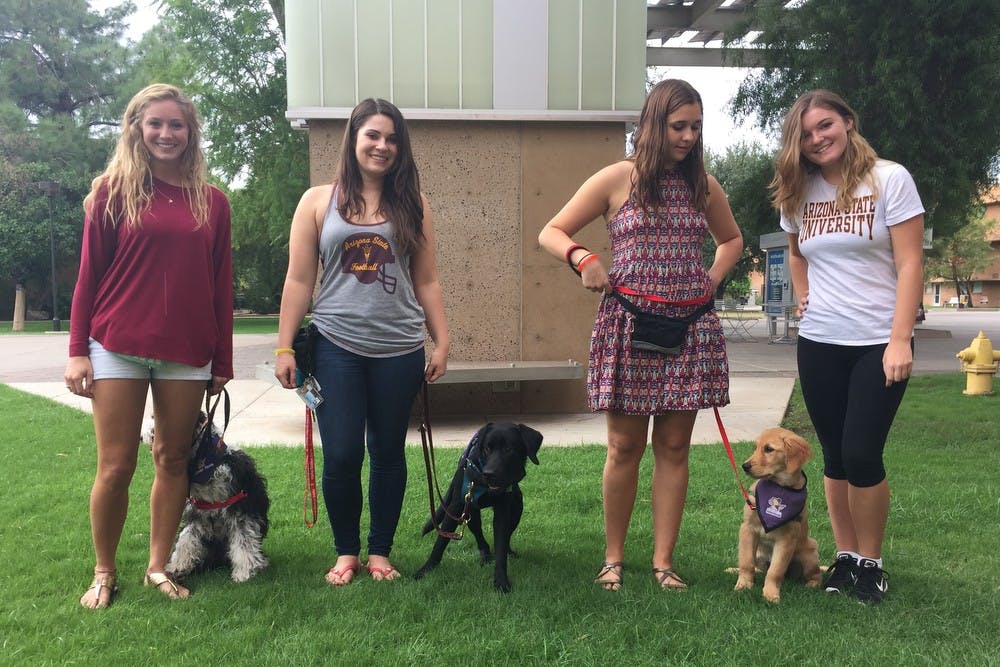Loved for their wagging tails and wet kisses, dogs have often been referred to as man’s best friend, but one ASU student organization is proving that they can do a lot more than sit, stay and fetch.
Sparky’s Service Dogs partners with Power Paws in Scottsdale to teach students how to properly raise, train and handle service dogs that have the potential to save someone's life.
Event coordinator and psychology sophomore Samantha Rodrigues said the mission of Sparky’s Service Dogs is to bring awareness to the community about service animals and how to handle seeing a service dog in the community.
“You can’t just go up to a service dog and start loving it,” she said. “Especially one in training, because that’s not effective for training.”
She said former students would travel to Power Paws to work with dogs, but after workers had seen a similar club succeed at Texas A&M, they decided to bring it to ASU. Five students started the club just before the spring 2015 semester.
Rodrigues said members go through training classes with Power Paws staff members, which teach them positive reinforcement training techniques. Students can become full-time raisers or handlers who take dogs a few times a month to train them.
Rodrigues added that taking the dogs to campus is an important experience because it exposes the dogs to situations that they wouldn’t otherwise run into when placed with future partners.
“It’s really worthwhile seeing where they get placed and knowing that you had a part in helping them get trained,” she said. “It takes a lot for them to get trained to then be able to get placed somewhere and knowing that you were a big part of that process is super awesome.”
Rodrigues said the club also reaches out to the community and works with other service animal organizations like Horses Help, which is an equine therapy organization.
Club president and kinesiology junior Taylor Randle is one of three club members who raise service dogs on campus. She said students who choose to be raisers train the dogs from puppies until they’re 2 years old and teach them more than 90 behaviors within that time frame.
Behaviors include turning lights on and off, undressing someone, opening handicap doors and doing a full load of laundry from start to finish.
Randle said trained dogs can serve a variety of different purposes from helping those with PTSD to being diabetic alert dogs.
For instance, diabetic alert dogs are trained to smell differences in blood glucose in a human, using saliva samples. When levels are below 80 or above 180, dogs know how to alert their human partner that something is not right.
“They’ll come and go crazy and touch you and pull on stuff until you say ‘what’s wrong,' ” Randle said. “Then they’ll either bow if it’s low blood sugar or jump up if it’s high blood sugar and they’ll push noisy buttons to alert you to take your insulin.”
Randle said the service dogs go to class with their trainers and that service dogs can enter a classroom because ASU is a public campus. She said the dogs are tested for temperaments before they are assigned to a student and that Power Paws doesn’t give students high-maintenance dogs.
Junior chemical engineering student Rhiannon Olshansky is currently raising a 4-month-old golden retriever. She said even though raising a service dog is rewarding, it can sometimes be difficult to balance being a student with taking care of an animal.
“My major is pretty tough and I have a lot of homework and she has severe separation anxiety,” Olshansky said. “She doesn’t like to be alone so I can’t just stick her in a crate.”
Once the dogs are trained, Randle said the placement process can be difficult for raisers, even ones who have done it for a long time.
“Growing up, you know about service dogs, but it never really clicked to me that someone actually raises the dog from puppy to older,” Randle said. “I was really excited to be a part of it and be a raiser and ever since I started, yeah it’s a lot of work, but it’s absolutely rewarding.”
Related Links:
Former UA researcher seeks new location to conduct marijuana PTSD study
Students help train dogs to serve disabled veterans
Reach the reporter at bridget.dowd@asu.edu or follow @bridgetbernice on Twitter.
Like The State Press on Facebook and follow @statepress on Twitter.




